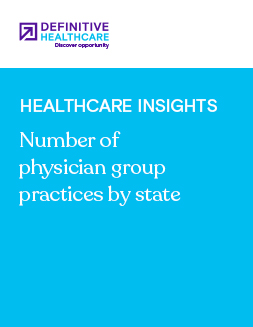Healthcare Insights
Breaking down U.S. hospital payor mixes
Understanding a hospital’s payor mix gives insight into the organization’s financial health and performance.
This Healthcare Insight reviews payor mix data for more than 5,700 U.S. hospitals and compares the results by hospital type, size, and location.
What is payor mix in healthcare?
Payor mix data represents the breakdown of revenues, charges, discharges, and patient days from different medical insurance payors. In the Definitive Healthcare HospitalView product, the proprietary calculation is based on a facility’s charge and revenue measures from the Medicare Cost Report.
What is the difference between payer and payor?
For the U.S. healthcare market, the terms “payor” and “payer” are often used interchangeably and have the same general meaning. As American Medical Association (AMA) recognizes “payor” as the preferable word, Definitive Healthcare has also adopted “payor” as our standard spelling.
Payor mix classifications
Payor mix breaks down into the following classifications: Medicare, Medicaid, and commercial/private/self-pay/other. Specifically, these payor mix categories are defined as:
Medicare: charges from beneficiaries who are 65 and older and part of the Medicare program.
Medicaid: charges from beneficiaries who are part of state Medicaid programs (also includes Medicaid Managed Care charges).
Commercial/private/self-pay/other: charges from any patients who have health insurance through their employer or marketplaces, those who do not have insurance or choose to self-pay, Medicare Advantage patients, and all other patients.
How is hospital payor mix calculated?
Using hospital revenue and charge data, we can estimate the allocation of revenue sources to derive individual hospital payor mixes. For example, if we know a hospital’s total patient revenue is $100 million, its Medicare revenue is approximately $25 million, and its Medicaid revenue is approximately $10 million, we could calculate a 25% Medicare, 10% Medicaid, and 65% commercial/private/self-pay payor mix.
What is the payor mix breakdown?
Results in the following analysis are aggregated from the most recent 12-month interval tracked in our database. The most recent full calendar year of data available at the time of publishing is for 2022.
Commercial, private, and self-pay represent the largest payor group for U.S. hospitals with net patient revenue of nearly $689 billion, or 69.2% of average payor mix.
Total net patient revenue for Medicare was more than $150 billion in 2022, or 18.5% of payor mix. Medicaid’s total net revenue was $133 billion or 14.1% of payor mix distribution.
In addition to revenue allocation, payor mix can also be analyzed by the percentage of patient days. For example, since Medicare patients represent an older population, patient cases might be more complex or patient comorbidities may lead to longer hospital stays.
Payor mix by total patient days breaks down as follows:
- Commercial/private/self-pay/other: 58.4%
- Medicare: 33.8%
- Medicaid: 9.3%
National payor mix total and average
Fig. 1 Data is from the Definitive Healthcare HospitalView product and sourced from the Medicare Cost Report. Accessed June 2024.
How has hospital payor mix breakdown changed year-to-year?
Medicaid enrollment increased with the expansion of the Affordable Care Act (ACA) and through the COVID-19 pandemic. In addition, the country faces an aging of the American population. With these factors potentially leading to larger Medicare and Medicaid populations, surprisingly, trends for Medicare and Medicaid payor mix show decreases in hospital patient days. Since 2013, the percentage of Medicare patient days decreased from 46.0% to 33.8% in 2022, and Medicaid patient days decreased from 11.1% to 9.3% in the same timeframe.
The percentage of commercial/private/self-pay patient days at U.S. hospitals has increased over the last 10 years from 44.2% in 2013 to 58.4% in 2022. In addition to rising healthcare costs, this could also reflect the increase in Medicare Advantage enrollment, which are Medicare Part C plans offered by commercial/private payors approved by Medicare.
Average percentage of payor days 2013-2022
Fig. 2 Data is from the Definitive Healthcare HospitalView product and sourced from the Medicare Cost Report. Accessed June 2024.
What is the payor mix breakdown by hospital bed size?
Hospitals with 25 or fewer beds have the highest Medicare patient days, where nearly half of patient days are for Medicare patients. In comparison, hospitals with more than 250 beds have more than two-thirds of patient days from commercial/private/self-payors.
The percentage of payor days correlates to hospital bed count, where the percentage of Medicare days declines and the percentage of commercial/private/self-pay days increases relative to a hospital’s number of beds. Facility specialties, insurance coverage, and hospital service area demographics likely contribute to these differences.
Average percentage of payor days by hospital bed size
Fig. 3 Data is from the Definitive Healthcare HospitalView product and sourced from the Medicare Cost Report. Accessed June 2024.
What is the payor mix breakdown by hospital type?
The highest percentage of Medicaid and commercial/private/self-pay patient days are at psychiatric hospitals. Rehabilitation hospitals have more than half of their patient days coming from Medicare beneficiaries while critical access hospitals had nearly half from this same group. This is likely tied to patient demographics.
Average percentage of payor days by hospital type
Fig. 4 Data is from the Definitive Healthcare HospitalView product and sourced from the Medicare Cost Report. Accessed June 2024.
What is the payor mix breakdown by hospital location?
Comparing the payor patient days by hospital region shows fairly similar results. Some differences include the Midwest having the highest percentage of Medicare days. Hospitals in the Midwest have the lowest average number of beds, and the analysis above shows that smaller hospitals tend to have higher Medicare patient days.
In addition, hospitals in the West have the least Medicare days and the most Medicaid days. California, Hawaii, and Alaska, for example, have some of the highest Medicaid payor mixes by state, contributing to the regional result.
Northeastern hospitals have more payor days from commercial/private/self-payors. Some of the largest hospitals in the U.S. by beds are located in the northeast, and larger hospitals tend to have higher commercial/private/self-pay days, according to our analysis above.
Average percentage of payor days by region
Fig. 5 Data is from the Definitive Healthcare HospitalView product and sourced from the Medicare Cost Report. Accessed June 2024.
Why does payor mix matter for commercialization?
Payor mix allocations help companies that sell and market to hospitals better segment and target accounts.
For example, if a durable medical equipment product is covered by Medicare, the sales team may want to prioritize hospitals with higher Medicare payor mixes. Or, if a new diagnostic test is not yet covered by insurance, the healthcare marketing team might first include hospitals with the highest commercial/private payor mixes in their email campaign.
Learn more
Healthcare Insights are developed with healthcare commercial intelligence from the Definitive Healthcare platform. Want even more insights? Start a free trial now and get access to the latest healthcare commercial intelligence on hospitals, physicians, and other healthcare providers.



